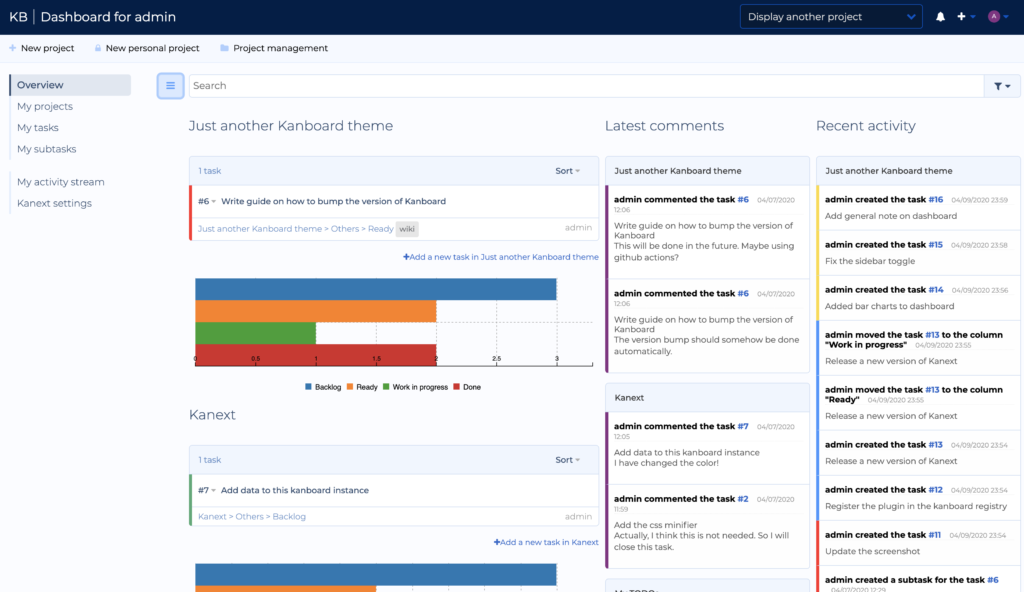A while back, I have started using kanboard as a personal task manager. It was a close call between it and other open source solutions and it won basically for being very-very easy to install. It has nice features – including automatic actions on various triggers – and it is very-very extensible with add-ons. However, soon after I realised I wanted some customisations – mainly looks, but also some functionality.
And this is how I begun making changes, which I posted in a github repository, in case anyone else found them useful. I named these changes “Kanext” which is supposed to be short of “Kanboard extended”.
Kanext
I have created this theme, mainly because I needed a better overview of my tasks. Also, I needed some functionality to be different than that of the base package – as mentioned above. Some examples are:
- toggling the sidebar for better workflow on small devices;
- close a modal when clicking outside;
- fixes on the templates (e.g. make the search box as long as the screen).

Some improvements, off the top of my head:
- improve on code quality, as the higher priority was to deliver functionality fast;
- add e2e tests and some automatic screenshot generation;
- improve the responsiveness.
The team todo setup
This is a simplistic way to setup a Todo board for a few members who work together as a team on various things – not necessarily IT, of course. 🙂
Also, should you find the following useful, you can try using them with other tools as well, not only Kanboard.
The board setup
Columns
- Sticky
Some of the tasks are on the longer term – e.g. learn a new skill, get a new certification – might need more time, together with visibility; - Backlog
Contains all the tasks which are waiting to be planned; - Ready
Contains the tasks the team chooses to work on – what is put in this column needs to be clear; - In progress
What everybody is working on; - For review
Work that is done and needs to be checked by somebody else in the team.
This column can be skipped, provided there is an agreement in the team that anything which moves to “Done” needs to be reviewed before being closed. - Done
Actions
- Assign the task to the user who moves the task to “In progress”;
- Change the colours depending on the status;
- Once closed, move the task to the “Done” column.
Team conventions and general rules
Kanboard is by default a kanban style board. Thus, the general rules of kanban apply. Those apply and others, out of which the following stand out:
- Use the same language in creating tasks;
- All new tasks are added to the backlog column;
- Add as much information as possible about what needs to be done – if you work on the task much after adding it, details will be welcome;
- Tasks travel only one column at a time, even if at some point two or more moves might be necessary – skipping columns when moving tasks might mean not triggering a predefined action;
- WIP limit should be set at least for the
Readycolumn – if there is no limit, you risk creating a second “Backlog” column; - In the dashboard, only
ReadyandIn progresscolumn content should be shown; - Tasks are ordered by priority, from top to bottom;
- Make use of swimlanes, even if not detailed in this example.
Sprints
In some teams, the concept of Sprints – having to complete a certain list of tasks in a given amount of time – helps productivity. Here are some simplistic suggested rules for small teams:
- Work in
1week/7daysprints which start on Monday; - Use Saturday morning – yes, I am a workaholic 🙂 – to plan whichever you want to work on during the next week. These tasks will be moved in the “Ready” column and even if nobody is assigned, there should be a general idea about who will work on what;
- New work will not be added to the sprint, unless there is a team agreement on it;
- The tasks in “Done” will be closed when the sprint closes.
Closing note
I have been using Kanboard for managing my tasks for quite some time now. The above rules come from continuously trying to improve on productivity. I hope they are good at least starting points and I hope you will find the theme easy to use and enjoyable.

